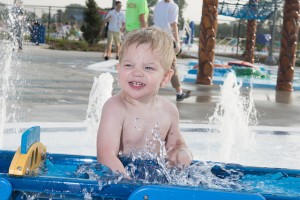Small children discover the world around them by using their senses. They touch, squeeze, smell, taste and look. Texture, colour, even the noise something makes as fingers are run over it – it all provides a motivation for play, and through that play, learning. Water and sand in particular provide countless opportunities for tactile, imaginative play. As plentiful substances they can be incorporated into all manner of outdoor and indoor activities, help a child experiment and, perhaps best of all, make a real mess.
Experts in early years education are unequivocal: sand and water play are invaluable when it comes to helping kids make sense of their world. Guidance material from the British Association for Early Childhood Education points out that a rudimentary grasp of mathematics can be gained from judging the weight of different containers of sand, or by thinking about when a container is empty or full of water.
The Northern Ireland Curriculum’s ‘Learning through play in the early years’ resource book lists a grounding in science as being one of the clear benefits of letting kids get wet and sandy. Exploring the differences between wet and dry sand, using water to turn sand into a building material and playing with water wheels and floating toys all encourage thinking about the way things work.
Stuck for ideas? A quick look through any decent education resources supplier’s listings is often just the needed spark to inspire children. Just a glance at the Hope Education online store reveals activity sets, jugs, watering cans, sand moulds, scales. And if that isn’t enough, here are some more ideas for you.

Water play
-
Experiment with warm or cold water – and show how warm water eventually cools.
-
Encourage blowing on or in water with straws to see how bubbles form.
-
See how some things float, some sink and some dissolve.
-
Demonstrate that water can be carried in things with no holes, but it leaks through items such as colanders and soaks through most fabrics.
-
Play with ice cubes and add food colouring to a bowl of water.
Sand play
-
Show that wet sand behaves rather like thick mud or dough, while dry sand pours almost like water.
-
Play around with scale. A sandpit is a great idea for outdoor play, but even just a few containers of sand over some sheets of newspaper is perfect for rainy days.
-
Introduce safe kitchen utensils – wooden spoons, small pans – and substitute sand for uncooked lentils or rice to play cook and practice stirring and mixing. This will foster interest in the real thing.
-
Toy animals, dinosaurs or figurines are a magical addition to any sandpit, and will stimulate all kinds of imaginative play.
-
Give children toy cars, plastic rakes or even old combs – these will help them make swirls and patterns in wet or dry sand.
-
Playing in a sandpit with other children is also a good way to teach a child about sharing and taking turns.
And, of course, after making all that mess, children can learn how to help grown-ups clean up!


1 Comment